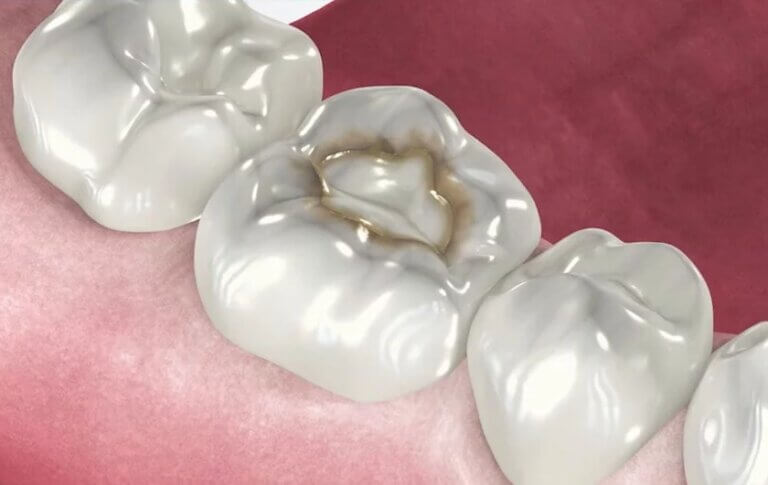A Cavity Under An Old Filling

What Is A Cavity Under An Old Filling?
If you’ve had a dental filling, you might think that the issue is resolved for good, but fillings aren’t always permanent. Over time, they can break down, leading to the development of a cavity underneath. A cavity under an old filling occurs when bacteria sneaks into the gap between the filling and the tooth, resulting in decay. This can happen due to an old or poorly placed filling. If left untreated, the decay can spread, causing severe damage to the tooth, including infection or the need for more extensive treatment, like a root canal or extraction.
If you suspect you have a cavity under an old filling, it’s crucial to seek professional dental care to avoid further complications. Here’s everything you need to know before booking an appointment with your Toronto dentist.
- Why Do I Have A Cavity Under An Old Filling?
- Signs And Symptoms Of A Cavity Under An Old Filling
- Treatment Options For A Cavity Under An Old Filling
- Managing A Cavity Under An Old Filling Until You Can See The Dentist
- Cavity Risk Self Quiz
- Frequently Asked Questions About Cavities Under An Old Fillings
If you have questions about A Cavity Under An Old Tooth Filling or other dental problems, please contact us for more information.
Why Do I Have A Cavity Under An Old Filling?
Several factors can contribute to the formation of cavities under old fillings:
- Worn-Out Fillings: Over time, dental fillings can wear down, crack, or shift, allowing bacteria to enter.
- Poor Oral Hygiene: Inadequate brushing or flossing can allow plaque to accumulate and attack the filling’s edges.
- Diet: Sugary and acidic foods create an environment where bacteria thrive, accelerating the formation of cavities.
- Improper Filling Placement: If the filling wasn’t properly sealed, gaps could form, letting bacteria in.
It’s essential to maintain good oral hygiene and visit your dentist regularly to catch these issues early. If you have further questions about a Cavity Under An Old Dental Filling, please contact us.

Signs And Symptoms Of A Cavity Under An Old Filling
Detecting a cavity under an old filling can be tricky since the filling hides the decayed area. Here are common symptoms to watch for:
- Tooth Sensitivity: If you notice sensitivity to hot, cold, or sweet foods, it may indicate a cavity beneath the filling.
- Pain or Discomfort: Pain when chewing or applying pressure could signal decay under the filling.
- Visible Damage: Cracks, discoloration, or changes in the appearance of the filling or tooth may suggest a cavity.
- Pus or discharge: If you notice pus or discharge around the affected tooth, it may indicate that an infection has developed due to a cavity under the filling.
- Bad Breath: Bad breath (halitosis) may be a sign of an infection caused by tooth decay under the filling.
If you’re experiencing any of these symptoms, schedule a dental appointment as soon as possible. Early detection can prevent the need for more complicated procedures. If you have further questions about signs and symptoms of A Cavity Under An Old Filling, please contact us.
Treatment Options For A Cavity Under An Old Filling
If a cavity forms under your filling, your dentist will recommend one of several treatment options depending on the extent of the decay:
- Filling Replacement: The decayed filling is removed, the cavity cleaned, and a new filling is placed. The material may vary depending on the location and size of the filling.
- Root Canal Therapy: If the decay has reached the tooth’s nerve, a root canal may be needed to remove the infected tissue.
- Dental Crown: If the tooth is weakened, a crown may be necessary to restore its strength.
- Tooth Extraction: In severe cases where the tooth can’t be saved, it may need to be extracted, followed by options like a dental implant or bridge.
Prompt treatment is crucial to preventing the decay from worsening. Be sure to discuss all your options with your dentist. If you have further questions about treatment options for A Cavity Under An Old Filling, please contact us.

Managing A Cavity Under An Old Filling Until You Can See The Dentist
If you suspect a cavity under an old filling but can’t see your dentist right away, here are some ways to manage the discomfort:
- Maintain Good Oral Hygiene: Gently brush and floss around the filling, and consider rinsing with a saltwater solution to reduce bacteria and inflammation.
- Use Pain Relievers: Over-the-counter pain medications like ibuprofen or acetaminophen can help manage discomfort. Follow dosage recommendations carefully.
- Avoid Sugary or Acidic Foods: These can exacerbate the problem, so try to avoid them until you can get dental care.
While these tips can help manage symptoms temporarily, they are no substitute for professional dental treatment. If you have further questions about managing A Cavity Under An Old Filling, please contact us.
Cavity Risk Self Quiz
Try Our free online dental caries risk assessment quiz based on the California Dental Association’s Caries Management by Risk Assessment (CAMBRA) designed for patients aged 6 years and older. This caries risk assessment tool is meant to give you an idea of your level of dental caries risk, and by no means substitute for an oral exam by a dental professional. Please contact us for a more complete examination.
Frequently Asked Questions About Cavities Under Old Fillings
- Why do cavities form under old fillings?
Cavities can develop under old fillings when gaps form between the filling and the tooth, allowing bacteria to enter. This is often due to wear, cracks, or natural aging of the filling material.
- Can I feel a cavity under my filling?
Not always, as some cavities may not cause pain or discomfort in the early stages. Regular dental visits are crucial for detecting hidden decay before it worsens.
- Can a cavity under a filling be fixed without removing the filling?
In some cases, if the cavity is accessible, it may be possible to treat the decay without replacing the entire filling. However, your dentist will assess the situation to determine the best approach.
- How can I prevent cavities under fillings?
Maintaining good oral hygiene, including brushing, flossing, and regular dental checkups, is key. Promptly addressing any issues with old fillings can also help prevent further decay.
Cavities under old fillings can compromise the health of your tooth if left untreated, but early detection and prompt care can restore your smile. Regular dental visits are essential for catching hidden issues and maintaining the longevity of your fillings. Contact us for more information about cavities under old fillings.

